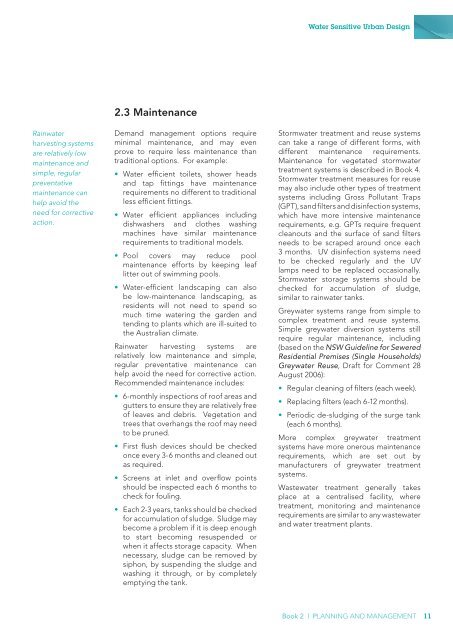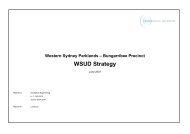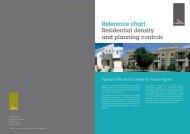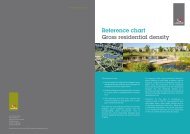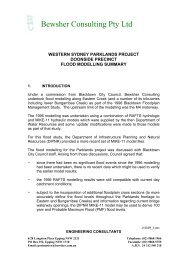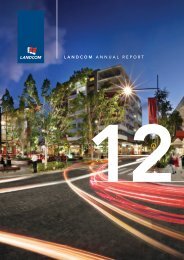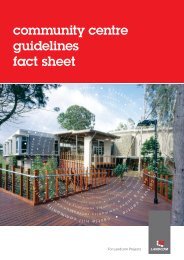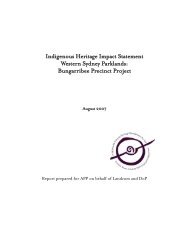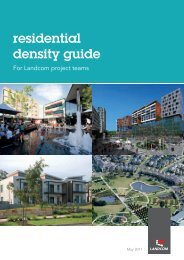Water Sensitive Urban Design
Book 2 | Planning and Management - WSUD
Book 2 | Planning and Management - WSUD
- No tags were found...
Create successful ePaper yourself
Turn your PDF publications into a flip-book with our unique Google optimized e-Paper software.
<strong>Water</strong> <strong>Sensitive</strong> <strong>Urban</strong> <strong>Design</strong><br />
Rainwater<br />
harvesting systems<br />
are relatively low<br />
maintenance and<br />
simple, regular<br />
preventative<br />
maintenance can<br />
help avoid the<br />
need for corrective<br />
action.<br />
2.3 Maintenance<br />
Demand management options require<br />
minimal maintenance, and may even<br />
prove to require less maintenance than<br />
traditional options. For example:<br />
••<br />
<strong>Water</strong> efficient toilets, shower heads<br />
and tap fittings have maintenance<br />
requirements no different to traditional<br />
less efficient fittings.<br />
••<br />
<strong>Water</strong> efficient appliances including<br />
dishwashers and clothes washing<br />
machines have similar maintenance<br />
requirements to traditional models.<br />
••<br />
Pool covers may reduce pool<br />
maintenance efforts by keeping leaf<br />
litter out of swimming pools.<br />
••<br />
<strong>Water</strong>-efficient landscaping can also<br />
be low-maintenance landscaping, as<br />
residents will not need to spend so<br />
much time watering the garden and<br />
tending to plants which are ill-suited to<br />
the Australian climate.<br />
Rainwater harvesting systems are<br />
relatively low maintenance and simple,<br />
regular preventative maintenance can<br />
help avoid the need for corrective action.<br />
Recommended maintenance includes:<br />
••<br />
6-monthly inspections of roof areas and<br />
gutters to ensure they are relatively free<br />
of leaves and debris. Vegetation and<br />
trees that overhangs the roof may need<br />
to be pruned.<br />
••<br />
First flush devices should be checked<br />
once every 3-6 months and cleaned out<br />
as required.<br />
••<br />
Screens at inlet and overflow points<br />
should be inspected each 6 months to<br />
check for fouling.<br />
••<br />
Each 2-3 years, tanks should be checked<br />
for accumulation of sludge. Sludge may<br />
become a problem if it is deep enough<br />
to start becoming resuspended or<br />
when it affects storage capacity. When<br />
necessary, sludge can be removed by<br />
siphon, by suspending the sludge and<br />
washing it through, or by completely<br />
emptying the tank.<br />
Stormwater treatment and reuse systems<br />
can take a range of different forms, with<br />
different maintenance requirements.<br />
Maintenance for vegetated stormwater<br />
treatment systems is described in Book 4.<br />
Stormwater treatment measures for reuse<br />
may also include other types of treatment<br />
systems including Gross Pollutant Traps<br />
(GPT), sand filters and disinfection systems,<br />
which have more intensive maintenance<br />
requirements, e.g. GPTs require frequent<br />
cleanouts and the surface of sand filters<br />
needs to be scraped around once each<br />
3 months. UV disinfection systems need<br />
to be checked regularly and the UV<br />
lamps need to be replaced occasionally.<br />
Stormwater storage systems should be<br />
checked for accumulation of sludge,<br />
similar to rainwater tanks.<br />
Greywater systems range from simple to<br />
complex treatment and reuse systems.<br />
Simple greywater diversion systems still<br />
require regular maintenance, including<br />
(based on the NSW Guideline for Sewered<br />
Residential Premises (Single Households)<br />
Greywater Reuse, Draft for Comment 28<br />
August 2006):<br />
••<br />
Regular cleaning of filters (each week).<br />
••<br />
Replacing filters (each 6-12 months).<br />
••<br />
Periodic de-sludging of the surge tank<br />
(each 6 months).<br />
More complex greywater treatment<br />
systems have more onerous maintenance<br />
requirements, which are set out by<br />
manufacturers of greywater treatment<br />
systems.<br />
Wastewater treatment generally takes<br />
place at a centralised facility, where<br />
treatment, monitoring and maintenance<br />
requirements are similar to any wastewater<br />
and water treatment plants.<br />
Book 2 | planning and management 11


